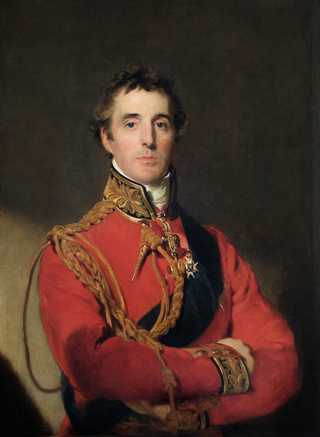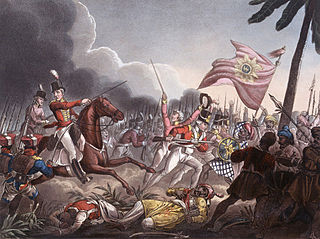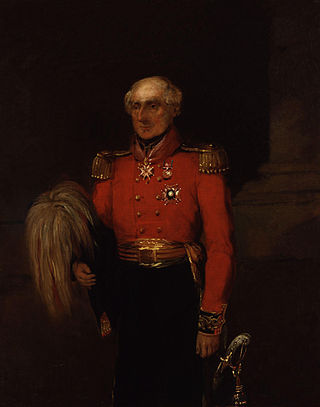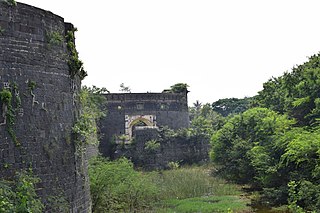
Field Marshal Arthur Wellesley, 1st Duke of Wellington, was an Anglo-Irish statesman, soldier, and Tory politician who was one of the leading military and political figures of 19th-century Britain, serving twice as prime minister of the United Kingdom. He is among the commanders who won and ended the Napoleonic Wars when the Seventh Coalition defeated Napoleon at the Battle of Waterloo in 1815.

The Maratha Confederacy, also referred to as the Maratha Empire or the Maratha Kingdom, was an early modern polity in the Indian subcontinent comprising the realms of the Peshwa and four major independent Maratha states who were often subordinate to the former. It was formed in 1674 with the coronation of Shivaji of the House of Bhonsle as the Chhatrapati of the Marathas. The Maratha realm was recognised by Bahadur Shah I, the Shahenshah of Hindustan as a tributary state in 1707 after a prolonged rebellion. The Marathas continued to recognise the Shahenshah as their nominal suzerain similar to other contemporary Indian entities.

The 76th Regiment of Foot was a British Army regiment, raised in 1787. Under the Childers Reforms it amalgamated with the 33rd Regiment to form the Duke of Wellington's Regiment in 1881.

The Battle of Assaye was a major battle of the Second Anglo-Maratha War fought between the Maratha Empire and the British East India Company. It occurred on 23 September 1803 near Assaye in western India. An outnumbered Indian and British force, under the command of Major General Arthur Wellesley, defeated the combined Maratha army of Daulatrao Scindia and the Bhonsle Raja of Berar. The battle was Wellesley's first major victory and the one he later described as his finest accomplishment on the battlefield, even more so than his more famous victories in the Peninsular War, and his defeat of Napoleon Bonaparte at the Battle of Waterloo.

The Second Anglo-Maratha War (1803–1805) was a large conflict within the Maratha Confederacy involving the British East India Company. It resulted in major loss of territory for the Marathas, including regions around Delhi and in present-day Gujarat falling into direct Company rule.

The Fourth Anglo-Mysore War was a conflict in South India between the Kingdom of Mysore against the British East India Company and the Hyderabad Deccan in 1798–99.

Gawilghur was a well-fortified mountain stronghold of the Maratha Empire north of the Deccan Plateau, in the vicinity of Satpura Ranges, Amravati District, Maharashtra. It was successfully assaulted by a force commanded by Arthur Wellesley on 15 December 1803 during the Second Anglo-Maratha War.

The Cis-Sutlej states were a group of states in the contemporary Punjab and Haryana states of northern India during the 19th century, lying between the Sutlej River on the north, the Himalayas on the east, the Yamuna River and Delhi District on the south, and Sirsa District on the west. The small Punjabi kingdoms of the Cis-Sutlej states paid tributes to the Marathas, until the Second Anglo-Maratha War of 1803–1805, after which the Marathas lost this territory to the British.

Sharpe's Triumph is the second historical novel in the Richard Sharpe series by Bernard Cornwell, first published in 1998. Sharpe is a sergeant in the army who attracts the attention of General Arthur Wellesley at Ahmednagar.

Mahadaji Shinde, later known as Mahadji Scindia or Madhava Rao Scindia, was a Maratha statesman and general who served as the Raja of Gwalior from 1768 to 1794. He was the fifth and the youngest son of Ranoji Rao Scindia, the founder of the Scindia dynasty. He is reputed for having restored the Maratha rule over North India and for modernizing his army.
Lieutenant-General Alexander Adams was a British army officer. He distinguished himself in the Second Anglo-Maratha War, serving with the 78th Highlanders in India. His commander, General Wellesley, thanked him for his services on several occasions. After the 1811 invasion of Java, he was appointed to a command in the army, and also as minister at the court of the emperor or Susuhunan Pakubuwono IV.

Lieutenant-General Sir Colin Campbell was a British Army officer and colonial governor.
In 1803 the Pettah of Ahmednagar, had forty bastions, or round towers: eight of them were large, with two guns in each; the remainder had only loopholes. There were twelve gates, without any detached works for defence. The walls were of mud, about 10 feet (3.0 m) high without a ditch.

The Ahmednagar Fort is a fort located close to the Bhingar Nala near Ahmednagar in Maharashtra state western India. It was the headquarters of the Ahmednagar Sultanate. In 1803, it was taken by the British during the Second Anglo-Maratha War. It was used as a prison during the British Raj. Currently, the fort is under the administration of the Armoured Corps of the Indian Army.
The Capture of Gawilghur fort in western India by British East India Company forces under the command of Sir Arthur Wellesley on 15 December 1803 during the Second Anglo-Maratha War was the culminating act in the defeat of the forces of Raghoji II Bhonsle, Rajah of Berar. Gawilghur's garrison of 3000 was commanded by Beni Singh Rajput, assisted by Manoo Bapu, who was the cousin of Raje Bhosale of Nagpur and Killedar Rana Shivsingh, a Rajput Commander of Narnala and also the Governor of Gawilgad and surrounding forts. Rana Shivsingh Rajput was brother-in-law of Jamadar Beni Singh Rajput.
Argaon, or Argaum is a village in the Ratnagiri district of Maharashtra state in (India). Ratnagiri is a coastal district on the Arabian Seafront. The landmass on the western part of Maharashtra along the Arabian Sea, sandwiched between the sea and a mountain range named Sahyadri, is known as Konkan. Argaon is situated in the foothills of the Sahyadri mountains.

General James Welsh was an English officer in the Madras Army of the East India Company.

Arthur Wellesley, 1st Duke of Wellington,, was one of the leading British military and political figures of the 19th century. Often referred to solely as "The Duke of Wellington", he led a successful military career in the Indian subcontinent during the Fourth Anglo-Mysore War (1798–99) and the Second Anglo-Maratha War (1803–1805), and in Europe during the Napoleonic Wars (1803–1815).
The Treaty of Surji-Anjangaon was signed on 30 December 1803 between the British and Daulat Rao Sindhia, chief of the Maratha Confederacy at Anjangaon town located in Maharashtra.
Amrut Rao was a Maratha noble, and the adopted son of Peshwa Raghunath Rao, who is also known as the First Maharaja of Karwi. In 1803, Yashwant Rao Holkar invaded his master's residence in Pune to resettle his dispute with Sindhiya, while Peshwa was out of city. Subsequently, Holkar set up an ad hoc council nominally headed by Amrut Rao, to punish Sindhiya and reassert his claims on Malwa. However, Baji Rao sought assistance from the British East India Company, whose advance forced Amrut Rao to flee Pune and make peace with Baji Rao Subsequently, Amrut Rao signed a treaty with the British, agreeing to give up all claims over the Peshwa's office in return for a pension and an estate in Peshwa Jagir of Bundelkhand.
















